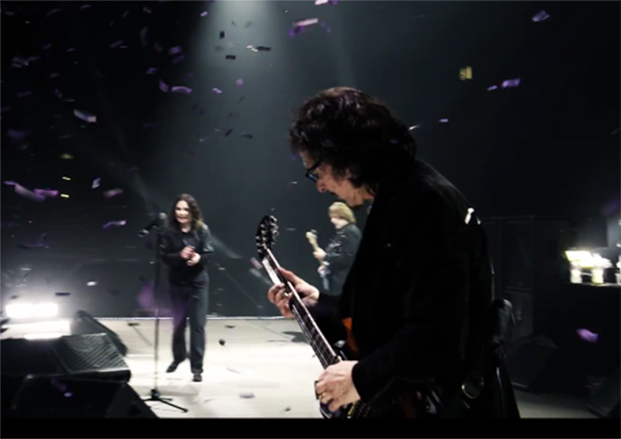Tony Iommi on Overwhelming Odds and the Right Way to Play "Paranoid"
Learn the correct way to play Black Sabbath's "Paranoid" riff from the writer himself in this classic GW lesson.

This entry is taken from the lovely Guitar World archives.
Hello there! Welcome to my first Guitar World column. I'm looking forward to sharing with you in these pages my thoughts on playing, equipment and the music business. Actually, this isn't the first time I've written a column—I used to do one many years ago for an English music magazine called Beat Instrumental. I did it for about eight months and it was great fun, and I'm sure this one will be too.
Although my handicap has received quite a bit of press over the years, a lot of people are very surprised when they find out that I'm missing two fingertips from my fretboard (right) hand. (I'm a lefty.) After all, that is a fairly serious affliction for a guitarist. Specifically, I lost the tips of my middle and ring fingers in an accident I had at work-they got caught in a piece of machinery. Ironically, the day the accident happened was my last day at that job before turning professional musician, as I was all set to go to Germany on tour with a band. The timing couldn't have been worse-not that there's ever a good time to cut off the ends of two of your fingers!
As you can imagine, it was an awful experience and I went through a terrible period of depression because I was convinced that my guitar playing days were over for good. I went to dozens of different doctors and hospitals and they all said, "Forget it. You're not going to be able to play guitar again." While I was down in the dumps though, a friend of mine, who happened to be my foreman at work, brought me a record of [world-renowned Gypsy jazz guitarist] Django Reinhardt who, at the time, I'd never heard of before. My friend said, "Listen to this guy play," and I went, "No way! Listening to someone play the guitar is the very last thing I want to do right now!" But he kept insisting and he ended up playing the record for me. I told him I thought it was really good and then he said, "You know, the guy's only playing with two fingers on his fretboard hand because of an injury he sustained in a terrible fire." I was totally knocked back by this revelation and was so impressed by what I had just heard that I suddenly became inspired to start trying to play again.
I tried playing right-handed for a while but that didn't work out for me so I bandaged my two damaged fingers together and started playing lefty again using just my first (index) and little fingers. I then decided to go a step further by trying to bring my two injured fingers back into the game. What I did was this: I melted down a "Fairy Liquid" [an English dishwashing detergent] bottle, made a couple of blobs of the plastic and then sat there with a hot soldering iron and melted holes in them so they'd fit on the tips of my injured fingers, kind of like thimbles. When I got the caps to fit comfortably, I ended up with these big balls on the ends of my fingers, so I then proceeded to file them down with sandpaper until they were approximately the size of normal fingertips.
It took me quite a while to get them exactly right because they couldn't be too heavy or thick but had to be strong enough so they didn't hurt the ends of my fingers when I used them. When I had sculpted my "thimbles" to the right size and tested them I realized that the ends weren't gripping the strings so I cut up a piece of leather and fixed pieces to the ends of them. I then spent ages rubbing the leather pads so they would get shiny and absorb some oils and would help me grip the strings better. I filed down the edges so they wouldn't catch on anything and it worked!
Once I had done this it took me quite a while to get used to bending and shaking strings with those two fingers because I obviously couldn't feel anything. It was difficult to even know where my fingers were and where they were going. It was just a matter of practicing and persevering with it, using my ears to compensate for my lost tactile sense. In the years since my story was publicized more than a few musicians who have had similar afflictions have told me that my "never say die" attitude has inspired them to keep going. However bad something may seem at first, you've got to try to overcome it because sometimes the "impossible" is possible. It was really depressing at first, but after hearing Django, I just wouldn't accept defeat. I was sure there had to be a way around my problem.
All the latest guitar news, interviews, lessons, reviews, deals and more, direct to your inbox!
PARANOID: THE RIGHT WAY
Anyway, that's enough about my missing fingertips! Let's finish up this first column with some music. Over the years a lot of guitar magazines and books have transcribed my "Paranoid" main riff but nearly all of them did so incorrectly. They invariably get the notes right but the position on the neck is always wrong. I saw one recently that made the same old mistake.
Nearly everyone (most professional transcribers included) assumes that I play the E5 power chord that the riff is based around on the 5th and 4th strings at the 7th fret. Well, I don't! I play the chord on the 6th and 5th strings at the 12th fret. I play it here because, to my ears, the E5 power chord at the 12th fret definitely sounds darker and more ominous than the 7th fret grip. (Compare both figures by playing them back-to-back and you'll hear exactly what I mean.)
Regarding the three grace-note hammer-ons that occur on the fifth string at the very beginning of the riff-they're definitely played by "feel" and will sound wrong if you perform them too quickly or too slowly. To get them right, listen to the recording carefully a few times until you've memorized the way that part of the riff sounds. Like the saying goes, "if you can hum it, you can play it!"

